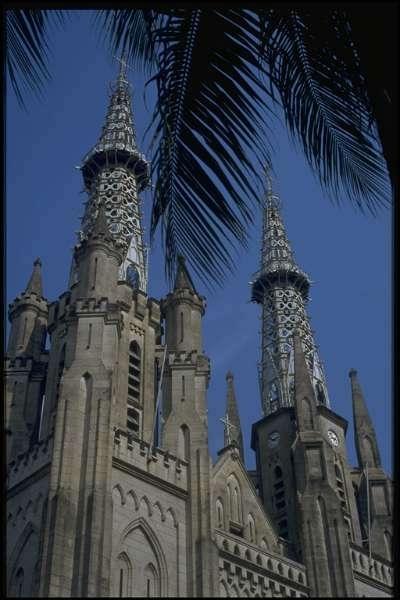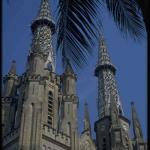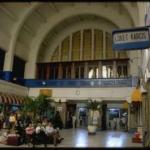In Search Of Old Jakarta
Prince Fatahillah would be rightly proud. The great Muslim warrior, commander of the army of the Sultanate of Demak, had on 22 June, 1527, freed the tiny trading port of Sunda Kelapa from the clutches of the avaricious Portuguese. This he did in two decisive battles, and renamed the town Jayakarta, meaning total victory. Once more, the pinisis - great ocean-going Bugis schooners - would be free to dock at will. They would have differed only in their size from the huge colourful pinisis that fill the ancient port gunnel to gunnel today. Sunda Kelapa now, as in pre-colonial days, is a truly Indonesian port. This has not always been the case.
Prince Fatahillah's victory, as glorious as it was, could save the tiny outpost for less than a hundred years. For the Dutch, under the auspices of their own East India Company - the VOC - would establish a trading post here. With a cunning mix of diplomacy and deception they set about establishing a trade monopoly through the Sunda and Malacca Straits. The city that they renamed Batavia soon became the centre of the Dutch colonial Empire in the east. The wealth came mainly from spice - pepper, nutmeg, cinnamon, and mace - for which European markets had voracious appetite.
Sunda Kelapa was at the marshy mouth of the Ciliwung River. The Dutch combined their considerable engineering skills with their considerable ignorance of local conditions to create a mini Amsterdam, complete with canals to drain the swamps and stuffy cottages. This they surrounded with a great stone fort, which kept at bay the foe and the fresh sea air as well. The Dutch would soon learn that an eastern Amsterdam was totally ill-suited to tropical climes. Stagnant canals became breeding grounds for malaria, cholera and typhoid. In the mid nineteenth century one in four of Batavia's European population died from tropical disease.
The colonists finally abandoned their home away from home and looked to greener pastures south of town. Sunda Kelapa was left to Chinese fishermen and traders; and to the schooners.
Jakarta is not renowned as a tourist destination. The CBD showcases mainly the gleaming glassy towers that house the offices and banks that in the eighties and nineties shot the Indonesian economy to the status of an Asian tiger. Yet relics of the olden days are there a'plenty to see. The abandonment of "Old Batavia" left many buildings almost totally intact. The old fort was torn down and used as fill for the festering canals. Left standing were the big fish market, some of the more substantial homes and the great warehouse which is now the Maritime Museum.
The VOC administered their "Empire" from the Stadhuis Plein, now called, appropriately, Taman Fatahillah. A little south-east of the port, the old cobblestone square has altered little since its heyday. The more celebrated buildings - the City Hall and the neo-classic Hall of Justice - now house, respectively, the Historical and the Modern Arts museums. The latter is worth visiting more for the bulding itself than for the exhibits it contains.
Modelled on Amsterdam's Stadhuis, the double-storey City Hall, complete with octagonal bell-tower, has a history as colourful as that of the colony itself. It was here that convicted recalcitrants were interred waste deep in water in the infamous dungeons. Some were executed on the gallows on the square, which at other times hosted festivals and markets. Happily, only the latter two events are witnessed in the leafy square today.
Visitors to present day "Kota", as the old Jakarta district is called, will appreciate the air-conditioned bliss afforded by the glamourous Cafe Batavia. It's a relic of the days of colonial indulgence, and boasts well-stocked bars upstairs and down, a gourmet restaurant and lots of arty photographs of screen and fashion icons of the fifties.
Running north-south through the Kota district is the Kali Besar, a stretch of the Ciliwung River that in colonial times was made into a canal. It was once the city's major thoroughfare, plied by cargo boats and ferries and lined on its banks with local women washing clothing and themselves. Behind them were the houses of the commercial elite. The canal still bears the same stigma of filth that forced the relocation. But a few of its grander homes remain. Pride among them is the Tokar Merah (Red House) with its painted red bricks and lavish mahogany interior. As it nears Sunda Kelapa, Kali Besar passes under the city's last remaining draw-bridge - the Chicken Market Bridge, where these days there's not a chicken to be seen.
At the entrance to the port stands the old watchtower. From its top you get fantastic views of the Sunda Kelapa docks, with the great pinisis - bows like giant multi-coloured swordfish - jammed in all along the wharf.
A visit to these ancient docks is a treat not to be missed. The schooners are sufficient attraction in themselves. Hand-crafted in Kalimantan and Sulawesi, they bring mainly timber to Jakarta from the bigger outer islands. Cargo is loaded and unloaded by hand. There's not a crane or a forklift to be seen. The sailors themselves are as charming, witty and welcoming as Indonesians always seem to be. Ladies, as colourful in personality as they are in dress, sell snacks and coffee to the sailors (and visitors) on the docks. They are quick to make the most of a potentially amusing situation, such as a camera-wielding tourist with an early morning craving for a good strong brew.
To the west of the wharf is a big kampung (local community) with lots of tiny shops and market stalls. It is one of the few places in Jakarta where you still can catch a becak. This traditional peddled taxi makes up for its spindly unobtrusiveness by having painted on its sides brightly coloured motifs from Indonesian folklore.
Much of old Jakarta has changed little in appearance since the founding years. But the old Dutch buildings and canals are the only things in these parts that are not of truly Indonesian origin. It does seem ironic that the birthplace of colonial Jakarta is now all but given over to the people through whose largely unrewarded work the Indonesian nation took its shape. Yes, Prince Fatahillah, casting a wise approving eye over Sunda Kelapa now, would have very good reason to be proud.
* * *
Old Jakarta Facts
Get There: Ansett Australia flies from Sydney to Jakarta daily, with connections available from other capital cities.
Stay: Ansett Australia Holidays offer Stopover Jakarta packages plus extended stay holiday packages and sightseeing tours out of Jakarta.
When: It's best to avoid the heaviest rains which come in January and February.
Bring: Light cottons, repellent, sun hat, sun block, comfortable walking shoes. Note that photography is allowed for a small charge in most of the Jakarta museums. Modest dress is advised.
Contact: Ansett Australia Holidays. Tel: 13 17 67
Visa: Not required for holders of Australian passports for stays of up to
Pitfalls: There have been incidents of muggings of foreign shoppers outside large Department stores. Until things settle down politically and economically, it's best to travel by taxi. Meters are usually accurate, but I have come across instances of tampering.
* * * * *
 ThingsAsian
ThingsAsian




















